Cardinals Clubhouse - III

Billy Southworth

Ray Sanders
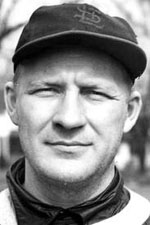
Whitey Kurowski
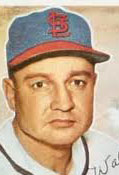
Walker Cooper
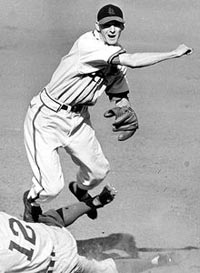
Marty Marion
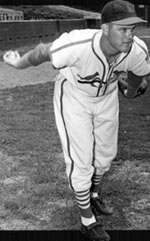
Red Munger
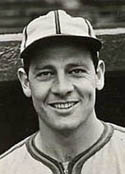
Frank Mancuso
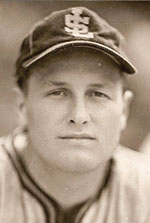
Jack Kramer
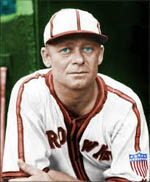
Sig Jakucki
|
The Cardinals entered the 1944 season as two-time defending NL champions.
- With all teams losing players to military service, the Redbirds were fortunate that six of their starting eight position players had escaped the draft.
1B Ray Sanders - irregular heart beat
3B Whitey Kurowski - osteomyelitis
C Walker Cooper - an old leg injury
OF Danny Litwhiler - bad knee
SS Marty Marion - back injury
OF Stan Musial - supported his father who suffered from black lung disease
Stan also had a son born before Pearl Harbor and worked in a steel plant back in Pennsylvania during the off-season. Still, Musial was fortunate that his draft board in Donora had a long enough list of able-bodied young men to fill their quotas so that they could continue the town's most famous resident's deferment.
On May 15, Stan was accepted by the Navy in St. Louis but no call-up date was given. The Cardinals braced themselves for his inevitable departure some time during the season.
In the meantime, he played under the three-year contract he signed before the season paying him $10,000 in '44, then $12,500, and $13,500.
- Still, the Cards had to replace a number of key players who entered the military after the 1943 campaign.
2B Lou Klein
OF Harry Walker
P Howie Pollet
P Howie Krist
P Al Brazle
P Ernie White
Another hurler, George "Red" Munger would leave at mid-season after compiling an 11-3 record and 1.34 ERA.
Nevertheless, everyone knew the Cardinals were head and shoulders above the other teams in the Senior Circuit. Only a rash of injuries and/or departures to the service could derail them.
- Billy Southworth usually started this lineup.
C Cooper
1B Sanders
2B Emil Verban, a 28-year-old rookie
SS Marion
3B Kurowski
LF Musial
CF Johnny Hopp, who played in only 91 games in '43 because of a back injury
RF Litwhiler
- In addition to Munger, the rotation included:
RHP Mort Cooper, who had won 20 games each of the last two seasons
LHP Max Lanier, the league's ERA leader at 1.90 in '43
RHP Ted Wilks, another 28-year-old rookie
LHP Harry Brecheen, a year older than Verban and Wilks who, like them, had toiled in the extensive Cardinal farm system for eight years before getting a chance in '43 because of the military departures; he went 9-6 with a 2.26 ERA
The club started fast, as expected.
- They won their first five before dropping two in a row at Cincinnati to briefly fall to third place.
- Four more consecutive wins put them in first place for good.
- By June 3, the Redbirds were 28-14 and up 5 games on Frankie Frisch's surprising Pittsburgh Pirates.
Meanwhile, St. Louis's other team, the Browns, had gotten off to their best start in years.
- Like the Cardinals, the Browns benefitted from draft deferments for key players, especially 1B George McQuinn and SS Vern Stephens, both of whom flunked their physicals. The only P taken before the '44 season was Steve Sundra.
- In the meantime, the Yankees had lost every starter from their '42 pennant winner and a few more from the '43 World Series champs.
- Browns GM Bill DeWitt shored up a big weakness behind the plate by signing rookies Red Hayworth and Frank Mancuso. The latter had joined the Army in '42 but was discharged after he broke his leg and hurt his back in a parachute jump.
- But the main reason manager Luke Sewell told his Brownies in spring training that they had a chance to win the pennant was four right-handed starters.
Nelson Potter, 32, who had gone 10-5 with a 2.78 ERA in '43 when the Browns fell to sixth after a surprising third place finish in '42, their best since 1928;
Jack Kramer, 26, who had been discharged from the navy because of severe sinus problems, called his mother back home in New Orleans every day, and pined for his beautiful estranged wife;
Bob Muncrief, 28,
13-12 2.81 in '43;
Denny Galehouse, 32, 11-11 2.73 in '43, who began the season pitching only on Sundays because he worked in a war plant in Ohio during the week.
- The Browns added another pitcher, Sig Jakucki, 34, who hadn't pitched in the majors since a brief stint with St. Louis in '36. Jack, as his teammates called him, had a well-earned reputation as a hopeless alcoholic who would disappear for days between starts. He threw a sinking fastball but was more likely to get hurt in a bar brawl than during the heat of diamond action.
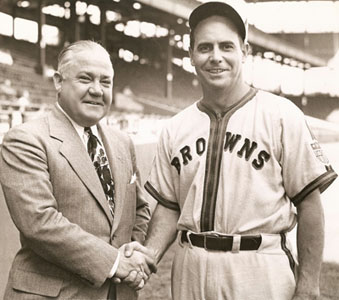
Browns owner Donald Barnes and manager Luke Sewell Sewell's collection of castoffs and 4Fers flabbergasted the baseball world by setting an AL record with victories in their first nine games, starting with a three-game sweep in Detroit.
- They didn't know it at the time, but the Tigers would spend the rest of the season wishing they had that series back.
- The Browns began to believe they really did have a shot at the pennant.
Sewell: When you get nine wins behind you, you got a talking point. So I just talked pennant all year long to them, and it probably caught fire a little bit.
McQuinn: After winning nine in a row to start the season, we began to think we could win the pennant. We realized that DiMaggio and Williams and all the rest of the big stars were off in the service. We were just as good as anybody else.
Falling back to earth, the Browns won only ten of their next 26 games to fall to third.
- But by June 5 they were back in first place by 1.5 games over the Yankees.
- The Browns hadn't so much risen to the level of the rest of the league as the other clubs had fallen to the Browns' level because of military defections.
To be continued ...
References: Cardinals Journal: Year by Year & Day by Day
with the St. Louis Cardinals Since 1882, John Snyder (2010)
The Spirit of St. Louis: A History of the St. Louis Cardinals and Browns,
Peter Golenbock (2000)
Even the Browns: The Zany, True Story of Baseball in the Early Forties,
William B. Mead (1978)
|
With the surprising Browns in first place in June, reporters commented on the fact that St. Louis's "other team" led the majors in 4-F players with 13.
- 1B George McQuinn
- 2B Don Gutteridge
- SS Vern Stephens
- Utility IF Ellis Clary and Floyd Baker
- OF Milt Byrnes
- C Red Hayworth
- P Jack Kramer, Al Hollingsworth, Sig Jakucki, Nelson Potter, Tex Shirley, and Sam Zoldak
The Cardinals couldn't match the Browns in quantity of 4-Fs but held an edge in quality.
- 1B Ray Sanders
- 2B Emil Verban
- 3B Whitey Kurowski
- P Mort Cooper, Harry Brecheen, and Ted Wilks
4-Fs were more important in evaluating a team's pennant chances because the other players might be drafted during the season.
Toward the end of May, Detroit manager Steve O'Neill predicted, Nobody is going to run away with the flag because no team was strong enough to separate itself from the rest.
- The Browns lost 34-year-old P Steve Sundra to the military after he made just three starts, winning two and compiling a 1.42 ERA.
- To offset that loss, manager Luke Sewell contacted RHP Denny Galehouse, who was working at a war plant in Akron OH and hadn't reported for spring training lest he lose his deferment and be drafted.
- Sewell offered Galehouse half a salary if we would pitch just on Sundays instead of twice a week as a full-time starter would.
- Denny had been working out as best he could at his lunch hour with the other workers and with local high school and amateur teams. He had also been running. He would end the season appearing in 24 games with 19 starts.
Galehouse recalled his regimen: On Saturday, I'd get an overnight train to wherever the Browns were playing. ... I'd get an upper berth. I'd get there at 7:30 or 8 o'clock in the morning. I'd have breakfast and go to the ball park ...We always had Sunday doubleheaders. I'd pitch the first game and then I'd leave and take the train and go back home. ... At first I pitched pretty good. ... Then I started getting out of shape. I was way behind in conditioning, and I could see that it was either one thing or the other - quit baseball altogether, or play full time. So I took a trip to Sarasota, Florida, where I had lived during the registration period for the draft. The chairman of the local board told him, "You probably wouldn't take your physical before the end of the season." ... I quit the job, and finished the season up, and I wasn't taken until April, and all I missed was the 1945 season.
- The Browns also got back hard-hitting OF Chet Laabs, who had been working in a defense-related plant in Detroit. GM Bill DeWitt got Laabs a job in a pipe manufacturing plant in St. Louis. Since Chet worked weekdays, he could play in home night games and on Saturdays and Sundays. He was able to quit the job at the beginning of August and play full time. He would log 66 games for the season.
Sewell's club played hard during games and every night as well.
- Luke asked trainer Bob Bauman to check that the guys were in their hotel rooms at midnight.
- Bob asked for a meeting with the boys to lay down the rules. I said, "Your manager and I have talked. He thinks we have a good chance for the pennant, and I think we've got a good chance for the pennant. But a lot of you have a tendency to go off the deep end. ... I'm going to check you every night at 12 o'clock and I want you to be in your rooms. That's all I ask. ... You could hear a pin drop. I never had any trouble. Oh, I found [P Tex] Shirley, you know, with a hat on in bed [prematurely bald, he wore a cowboy hat at all times], or someone stiff underneath the bed. ... During a ball game you couldn't ask for a better bunch. They worked. Off the field it was something else.
- A number of Browns had a drinking problem.
P Sig Jakucki would often disappear on the days he wasn't pitching. He spent his off time working the bars, home and away.
Just as Jakucki had failed to maximize his baseball potential, Shirley's penchant for booze had gotten him released by the Athletics, among other clubs.
Another alcoholic, CF Mike Kreevich, was so well-liked and so valuable
that teammates insisted he see a priest in St. Louis. With counseling and his wife keeping him on a short leash at home, Mike stayed sober for most of the season and had his best season at the plate (.301) since 1939.
Stephens, in addition to a fondness for liquor, had an insatiable appetite for feminine companionship. Numerous times he asked roommate Don Gutteridge to vacate their hotel room so he could entertain a guest in private. Don, a teetotaler, told GM DeWitt that his batting average would be 20 points higher if Stephens would let him get more sleep.
Gutteridge recalled an intervention by the GM that backfired. Charley DeWitt called him in the office one day, and he said, "Vern, for criminy's sakes, we've got a chance to win this pennant. Now why don't you take care of yourself, and quit running around at night, and get in bed and get your rest? Because you can help us, you're the best hitter on the ballclub. With your help we can win this thing and make some money out of it."
So Vern says, "All right." And for three weeks he quit drinking and going out, and never got a base hit. So Charley DeWitt called him in and said, "Go out and stay out!" I really think those guys did that sort of thing to loosen up.
The Browns stayed in first place from May 31 to the All-Star break July 10-12.
- The surprising Red Sox trailed by 2.5 games.
- The Yankees held third, a game behind Boston.
- The closeness of the race was illustrated by the fact that the leading Browns were 11 games over .500 (45-34) while the last-place Philadelphia Athletics were only seven games under (35-42).
Three Brownies made the 25-man AL roster for the Midsummer Classic in Pittsburgh.
- McQuinn, hitting .265, started at 1B.
- Stephens, a .301 hitter, started at SS. Manager Joe McCarthy of the Yankees installed Vern in the cleanup spot.
- Bob Muncrief, wiith an 8-4 record, earned a spot on the pitching staff. He pitched an inning and a third in the 7-1 loss to the NL team.
In the Senior Circuit, the Cardinals had opened a 9.5-game margin by the break.
- They had spent only three days out of first place and that was the first week of the season.
- Pittsburgh ran second with Cincinnati third, a game behind the Bucs.
- Unlike the AL, where only nine games separated the first- and last-place clubs, the woeful Boston Braves were already 23.5 games behind the Redbirds.
The National League starting lineup included three Cardinals with one more regular on the bench.
- Stan Musial, leading both leagues in hitting at .366, started in CF.
- Walker Cooper (.305) began the game behind the plate.
- Marty Marion (.253) played the whole game at SS.
- Billy Southworth, managing the NL club for the second straight year after the Cardinals' repeat pennant, put Kurowski (.276) at 3B for the sixth inning to replace starter Bob Elliott of the Pirates.
- Oddly, the six-man pitching staff didn't include a Cardinal, in part because every team in the league had to have at least one representative.
Continued below ...
References: The Spirit of St. Louis: A History of the St. Louis Cardinals and Browns,
Peter Golenbock (2000)
|
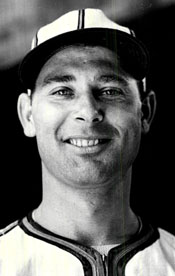
Steve Sundra

Denny Galehouse

Chet Laabs
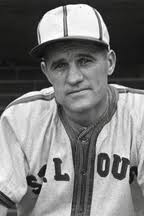
Mike Kreevich

Vern Stephens
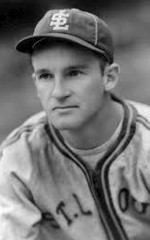
George McQuinn

Bob Muncrief
|

Mort Cooper
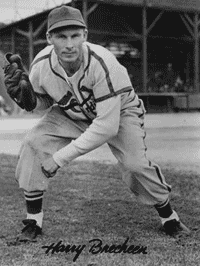
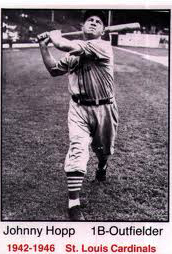
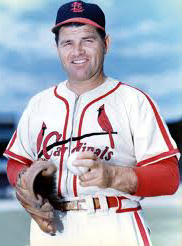
Max Lanier

Ted Wilks
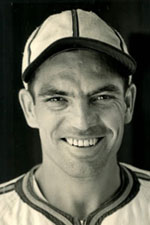
Don Gutteridge
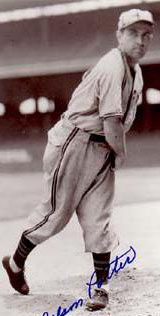
Nelson Potter
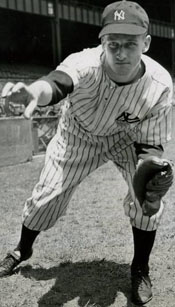
Hank Borowy

Snuffy Stirnweiss

Hal Newhouser (L)
and Dizzy Trout

Dick Wakefield
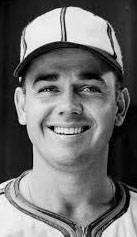
Al Zarilla
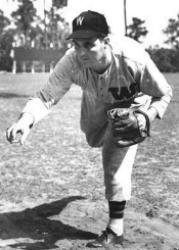
Dutch Leonard
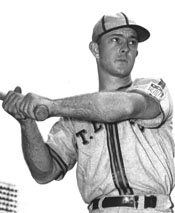
Chet Laabs
|
The Cardinals began the second half of the 1944 season up by 9.5 games over Frankie Frisch's Pirates.
- By the end of July, Billy Southworth's club extended their lead to 15 games thanks to a nine-game winning streak (July 23-29).
- The Redbirds made the NL pennant race so boring that they drew only 461,958 to Sportsman's Park, just the fifth best attendance in the league.
- St. Louis took particular delight in pummeling their archenemy, the Brooklyn Dodgers, who were decimated by military callups. The Redbirds won 18 of 22 against Leo Durocher's seventh-place club. They did almost as well against the last place Philadelphia Blue Jays: 17-5.
- On the other hand, Frisch knew how to beat his former club. The Pirates won 12 and lost 10 against St. Louis, a big factor in the Bucs' 2nd place finish. Included was a four-game sweep in Forbes Field September 1-3.
- The Cardinals finished 105-49, the exact mark they posted in '43 and their third straight season with 100+ victories - a first in NL history.
- Stan Musial led the league in hits (197), doubles (51), on-base percentage (.440 as calculated retroactively), slugging % (.549). However, his .347 average trailed Dixie Walker of Brooklyn by ten points. Johnny Hopp finished fourth in batting t .336 while C Walker Cooper came in seventh at .317.
- 31-year-old Mort Cooper won 22 and lost 7 and led the NL in shutouts with seven. The older Cooper brother became a poster child for players who capitalized on the weakened lineups of the war years. He won 65 games in the three war years but only 63 in his other eight campaigns combined.
- The records of the other four starters read like this: Max Lanier 17-12, Ted Wilks 17-4, Harry Brecheen 16-5, and Red Munger 11-3.
- As all-around team as you can find, the '44 Cards made the fewest errors in the league (112) and turned the most DPs (162).
- Danny Litwhiler recalled the Redbirds' style of play. In 1944 we played the same Billy Southworth baseball. He never went for the big inning. Get a man on and get him over. At the time, we defined National League baseball. What I remember most about '44 was that every day you knew you were going to win. ... if you lost, so what? "We'll get them tomorrow." And we did. It was so easy. And it wasn't one person who did it. It was always someone new.
The AL pennant race provided much more excitement.
- St. Louis's other team also led at the All Star break - 2.5 games over the Red Sox and 3.5 over the Yankees. The Tigers resided in seventh place, 8.5 out. In fact, only nine games separated the eight teams - mediocrity epitomized.
- No one was more surprised at the Browns' success than the manager and players.
Manager Luke Sewell: I thought just like anyone else that we'd be lucky to get through the year. It was such a makeshift club. Quite a few of the players were marginal from a major league standpoint.
1B George McQuinn: I don't think any of us who had been with the Browns for a number of years ever gave a thought to winning the pennant. Oh, no. we were the Browns and had never done anything like that.
2B Don Gutteridge: That was the trouble with the Browns. They had some pretty good ballplayers but they had a defeatist attitude. They didn't think they could do it; they didn't have the confidence. They said, "Oh, what the hell, we're going to lose anyway." And that attitude was eating up the Browns, really, year after year.
- The common opinion was that the Browns would fade in the second half of the season. Dan Daniel of the New York World Telegram wrote, Here in the East, we still adhere to the notion that the American League race will settle down to another battle between the New York and Washington clubs. Daniel referred to the Browns as "the Sewell surprises, the Luke Lallapaloosas."
But the Lallapaloosas didn't fade, at least not right away.
- They won ten in a row from July 28 to August 10 and extended their lead to 7 games on August 17 when Nelson Potter won his 12th game, two more than in any previous season. Other teams attributed Nelson's success to a newly-found spitball.
- Then St. Louis lost eight of its next nine and 16 of 23 so that by Labor Day they had fallen a half game behind the Yankees and just two ahead of Detroit. Some Browns thought the club relaxed with the big lead, figuring they had it won. After all, hardly any of them had ever been front-runners. The Tigers beat the Browns three of four on back-to-back weekends. The American League suddenly had its tightest race since 1908.
- The Yankees' success was almost as unexpected as the Browns'. Only three of Joe McCarthy's starters returned from the '43 World Series champions: 1B Nick Etten, SS Frankie Crosetti (who spent the first part of the season working in a war plant in California), and OF Johnny Lindell. Of the top starting pitchers, only Hank Borowy and Tiny Bonham were back. But 2B Snuffy Stirnweiss would hit .319 and lead the AL in runs and hits while 34-year-old OF Hershel Martin, out of the majors since 1940, would hit .302.
Sewell thought the Yankees should have won the pennant: They had the personnel. A better team? Oh, yes. ... practically all of them had come through their farm system ... McCarthy had a system of baseball. He just turned those big bats loose and let 'em go. ... But those big bats weren't there. They were in the Army. He was still playing that same kind of baseball, as if he had DiMaggio, Keller, Henrich, Dickey. Any number of games, if he had dropped some sacrifices in and things of that kind he would have won them from you.
- The Tigers boasted two of the league's best hurlers in Dizzy Trout and Hal Newhouser (27 and 29 wins respectively). But the rest of the staff was so weak that the two aces often relieved each other. Steve O'Neill's club received a shot in the arm when OF Dick Wakefield was unexpectedly discharged by the Navy on July 13. He would drive in 53 runs and smack 12 HRs in 78 games.
- Entering the stretch run, Sewell started mixing and matching his lineup to play who has hot and bench who was not.
Midway through September, the Browns got a taste of the uncertainty wartime teams faced when OF Al Zarilla was scheduled to report to the Army in California. GM Bill DeWitt arranged a deal with Jefferson Barracks in St. Louis that allowed Al to finish the season, then enter the Army there the next day.
A scheduling quirk gave the whole league four days off September 11-14. The top half of the standings looked like this.
| Team |
W |
L |
% |
GB |
| Yankees |
76 |
61 |
.555 |
-- |
| Tigers |
75 |
61 |
.551 |
0.5 |
| Browns |
75 |
62 |
.547 |
1 |
| Red Sox |
73 |
64 |
.533 |
3 |
The Browns returned to St. Louis to stay - 17 games to end the season.
- The homestand began with three victories in four games against the White Sox. Denny Galehouse evened his record at 13-13, Jack Kramer twirled a one-hitter for his 14th victory, and Potter snared his 16th win. Both St. Louis and Detroit leapfrogged New York, which fell two behind thanks to a disastrous and ill-timed sweep by the 5th-place Athletics.
- The four Eastern teams now toured the Western cities for the remainder of the campaign. The Browns took two of three from the Senators, then swept three from the A's as Kramer won two more starts. But the Browns actually lost a half-game to the Tigers, who beat NY two of three and took four-of-four to knock the Red Sox out of the race, while the Yanks faded to 4.5 behind.
The regular season now entered its final week.
- Monday, September 25: When Philadelphia beat the Tigers 2-1 and Potter shut out the Red Sox 3-0, the Browns pulled into a tie.
- Tuesday: Both Trout and Sig Jakucki twirled shutouts to maintain the stalemate.
- Wednesday: Newhouser shut out the Athletics. Rain fell all day in St. Louis. If the Browns played and won, they would remain tied with Detroit. But if they played and lost, they would fall one game behind. If the game was cancelled, they would be 1/2 game out with no chance to replay the rainout. The Red Sox were scheduled to take the 6 o'clock train to Chicago, and there was no pullman that night to the Windy City. Wanting to play the game, Sewell got Red Sox manager Joe Cronin to agree to stay overnight after the game since his club had an off day to travel Thursday. But the move backfired on Sewell as journeyman Pinky Woods outpitched Galehouse in a steady rain, 4-1. Luke was philosophical. What difference does it make whether I lose the pennant by half a game or a game?
- Thursday: Winners of ten of 18 games against the Browns that season, the Yankees came to St. Louis trailing by three with four games to play. Meanwhile, the Tigers hosted the lowly Senators whom they had beaten 15 of 18 times. To make matters worse, St. Louis lost the coin flip and would have to play the Tigers one game in Detroit should the race end in a tie. You couldn't blame the Browns if their season-long optimism waned. Galehouse: We felt really down. ... It was a dismal-looking situation.
But the rain continued, washing out the opener in St. Louis as well as the game in Detroit. Friday doubleheaders were set in both cities.
- Friday: The Tigers took the opener 5-2 and, with Trout starting the nightcap, felt confident of a sweep. But the last-place Nats rose up and knocked out Dizzy after four innings and take the nightcap 9-2. Further South before a disappointing turnout of only 6,172, the Browns kayoed the Yanks' pennant hopes by winning 4-1 behind Kramer and 1-0 as Potter extended his scoreless streak to 25 1/3 innings thanks to a great catch by CF Mike Kreevich and another outstanding play by Gutteridge. That threw the race back into a flatfoot tie with two games to go.
- Saturday: 12,982 saw Galehouse continue his stellar pitching, extending the Browns' scoreless inning streak to 26 innings, 2-0 with the help of 3B Mark Christman, who made a fantastic lleaping catch on Lindell's line drive headed to the LF corner. But the Tigers kept pace, 7-3 behind Newhouser.
Sewell planned to send his alcoholic righthander, Jakucki, to the hill on Sunday. Trainer Bob Bauman recalled what happened Saturday evening.
The night before our last game, we were staying at the old Melbourne Hotel. Jakucki was going to work on Sunday, and this meant everything; it meant the World Series. So the boys were watching him about drinking.
So Sig comes in the hotel about 11 o'clock at night carrying a big bag. A bag of whiskey; that's the way he carried it. Zack Taylor was a coach, and he hollered at him, "You're not going to take that to your room!" Jakucki says, "You're not going to take it away from me!" Taylor says, "You're not going to drink that tonight, I'll tell you that." Jakucki says, "I tell you. I won't drink tonight." Taylor says, "I don't believe you." Jakucki says, "I promise you I won't take a drink tonight. But don't try to take the liquor away, or there'll be trouble."
So the next thing I saw of Jakucki was at the ball park the next day before the ball game. I'm working on him. I can see he's been drinking. He says, "I kept my promise last night. I told him I wouldn't take a drink last night but I didn't promise I wouldn't take one this morning."
Jack Kramer had also beseeched Sig the night before. "Sig, this is important. This could mean the pennant to us. Can't you, one night, lay off the stuff and come in shape. Because we really need you.
Sig agreed, but when Jack gave him an "attaboy" the next morning at the park for staying sober, Jacucki replied, I got to have a little something before I go out there.
- Sunday: The Tigers started first in the Eastern time zone. O'Neill decided to start Trout on only one day's rest. The Senators went with 34-year-old knuckleballer Dutch Leonard who, 32 years later, admitted a bribe offer of $20,000 to "have a bad day" from an anonymous caller before Dutch left his hotel room. The visitors broke open the scoreless game with a 3-spot in the fourth off Trout. Leonard made that margin stand up, 4-1.
Meanwhile, in the Mound City, it was as if the fans finally decided the Browns were for real as the line for tickets began forming at 7 AM. But the Yankees took an early lead to strike fear into the hearts of the throng of 35,518 - largest attendance by far for any game in Sportsman's Park that season and the first time the Browns had filled the Park since its seating capacity had been expanded in 1925. (An estimated 15,000 more were turned away.) The Bombers plated a single run in the 1st on a throwing error by SS Junior Stephens and another in the 3rd with the aid of another error. But the Browns tied the game with 2 in the 4thwhen LF Chet Laabs teed off on a fastball from Mel Queen that hit the scoreboard at the back of the LF bleachers. In the next inning, Chet struck again, this time swatting a slow curve off the scoreboard with Kreevich on base again for a 4-1 lead. With Sig pitching a masterful six-hitter, St. Louis won 5-2 to cop the first pennant in franchise history. It was fitting that their winning percentage of .578 (89-65) was the lowest in AL history.
IF Ellis Clary on Chet Laabs: Chet was another strange, quiet guy. He never said nothing, and he couldn't get a damn sign for some damn reason. ... But he could hit a ball an awfully long ways. He wasn't very tall, but he had arms like Popeye. How he hit a ball as far as he could, ain't nobody ever figured it out. It was magical.
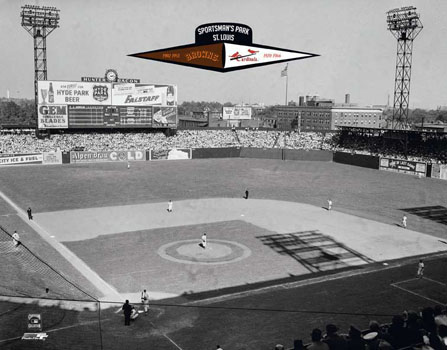
Sportsman's Park Scoreboard So St. Louis became the first city to host all games of a World Series in the same ballpark since the '22 Fall Classic between the Yankees and Giants at the Polo Grounds.
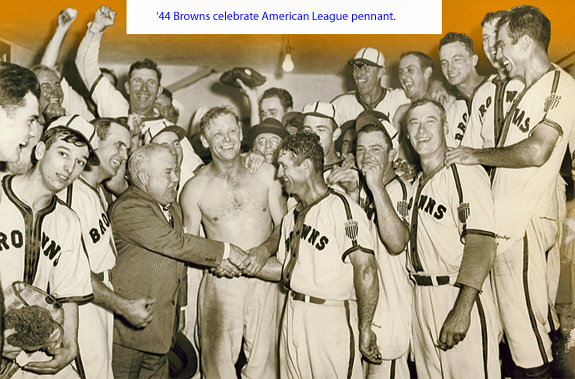 To be continued ...
References: Even the Browns: The Zany, True Story of Baseball in the Early Forties, William B. Mead (1978)
The Spirit of St. Louis: A History of the St. Louis Cardinals and Browns,
Peter Golenbock (2000)
|
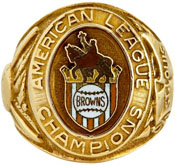
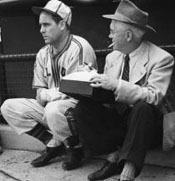
Browns manager Luke Sewell being interviewed
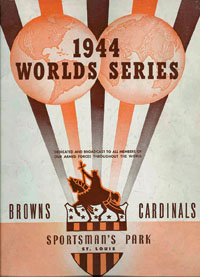
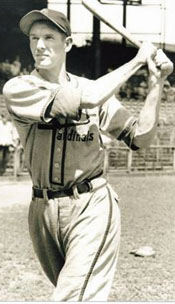
Marty Marion, 1944 NL MVP
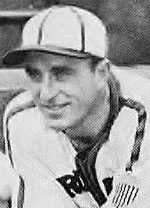
Denny Galehouse
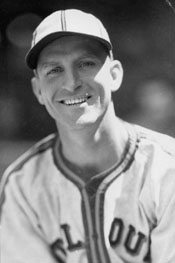
Gene Moore
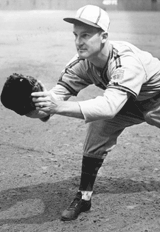
George McQuinn
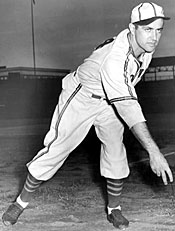
Nelson Potter
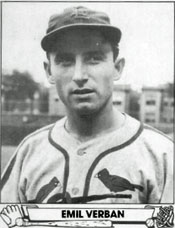
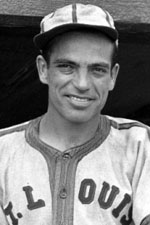
Don Gutteridge
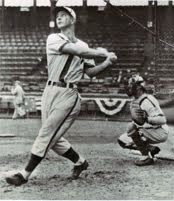
Chet Laabs
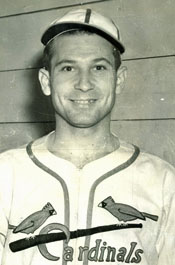
Blix Donnelly

Johnny Hopp & Stan Musial

Vern Stephens
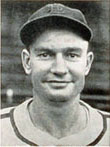
Walker Cooper
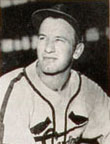
Freddie Schmidt

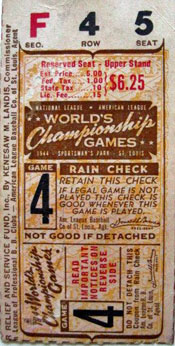
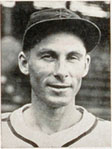
Harry Brecheen
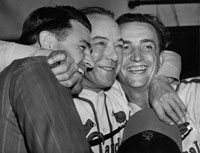
Southworth hugs his Game 6 pitchers, Lanier and Wilks
|
Just as Washington D.C. was labeled "first in war, first in peace, and last in the American League," St. Louis was known for being "first in shoes, first in booze, and last in the American League." But the 1944 St. Louis Browns turned conventional wisdom on its ear as they faced their Sportsman's Park tenants, the St. Louis Cardinals, in The Streetcar Series.
- The smart money was on the Cards, the first team to win 100 games three years in a row and playing in the franchise's eighth World Series while the Browns competed in their first Fall Classic. Bookies set odds of 1-to-2 that the Cards would take the Series.
- Card manager Billy Southworth had the luxury of stacking his starting pitching down the stretch after clinching the pennant. So he had 22-game winner Mort Cooper ready for Game One. Billy's main problem was his team's overconfidence. SS Marty Marion, the NL MVP that year, recalled: We thought we were going to just walk through them. Who in hell's the Browns?
- Luke Sewell, on the other hand, had to go to the last day to win the AL pennant as his team captured 11 of their last 13. Playing cagy, he told Denny Galehouse, a nine-game winner after pitching only on Sundays during the early season because of his job at a war plant, that he would start the first game but vowed him to secrecy. Even his teammates were surprised. They expected Nelson Potter.
Before they could lead their teams into the Series, Southworth and Sewell first had to settle where they would sleep. With a wartime housing shortage, the two skippers and their families shared an apartment all season because one St. Louis team was
always on the road when the other was home. Sewell kept his clothes at one end of the men's closet with Billy's at the other end. When the Browns hit the road, Mrs. Sewell and her two daughters entrained for the family home in Akron OH. Likewise, Mrs. Southworth and her nine-year-old daughter traveled to the family farm in Columbus OH when the Cardinals played away from St. Louis.
What to do for the Series? Baseball couldn't have the opposing managers sipping drinks together in their living room each evening rehashing the day's game. Fortunately, a resident in the apartment building who was out of town in October let the Southworths use his place.


Fans line up for Pavilion tickets at Sportsman's Park for the 1944 World Series
Game One
- The Cards banged out seven hits to just two for the Browns. But the two safeties came back to back in the fourth inning: a single by RF Gene Moore and a homer by 1B George McQuinn that barely reached the roof of the right field pavilion.
- Meanwhile, the Redbirds left nine men on base and couldn't scratch until the bottom of the ninth when SS Marty Marion doubled to center field, moved to third on a groundout, and scored on Ken O'Dea's fly (not a sacrifice fly in 1944).
- So the result was a surprising 2-1 victory for the upstart Brownies.
- Marion: By the time we got in that first game, we found out they were a pretty good ballclub. Yes, sir. ... They were tough. ... We had a good ballclub but it wasn't great. They had quite a bit of pride.
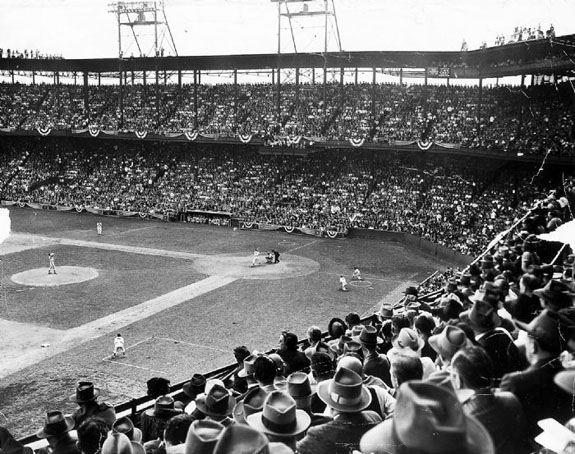
1944 World Series, Game One
Game Two
- Once again, pitching prevailed as each team collected seven hits.
- Browns screwballer Nelson Potter (some also called him a spitballer) gave up two runs, both unearned in six innings. In the 3rd, 2B Emil Verban led off with a single to left field. P Max Lanier bunted. Sewell recalled the crucial play like this: We made six misplays on the ball. That's pretty difficult. He popped a little ball down the third-base line. Potter and Christman came over to it. They looked at each other and let the ball drop, and Potter picked it up and he rolled it up his arm. That's two misplays. He threw it to Gutteridge at first. Little Don was trying to hold his foot on the bag and get the ball, when he should have gotten off and caught the ball. It went down into right field. That's three. Chet Laabs let it hit that right field wall there, reached over to pick it up and it rolled through his legs. That's four. He picked the ball up and fumbled on his pickup, that's five, and threw it away at second base. That's six misplays on the one ball. Potter was given two errors on the same play to send Verban to third base and Lanier to second. Verban then scored on LF Augie Bergamo's groundout.
- The Cards doubled their lead the next inning when 1B Ray Sanders walked with one out and went to second on 3B Whitey Kurowski's single. Marion hit a grounder to third base that should have started an inning-ending double play, but Mark Christman booted the ball to load the bases. Verban then drove home Sanders with a fly to left field.
- Going into the 7th, southpaw Lanier had allowed only one hit, a bunt single by Moore in the 5th. After Hal retired the first two batters, the Browns broke out. Moore singled, and C Ray Hayworth doubled off the left field wall to end the shutout. Then the other Browns C, Frank Mancuso, pinch-hit for Potter and singled to center field, scoring Hayworth to tie the game.
- As the game went into extra innings, the Cardinal fans, in a minority in the stands because of the appeal of the underdog, worried that their heroes would unbelievably fall two games behind.
- In the top of the 11th, Cardinal reliever Blix Donnelly made a play that is still remembered. McQuinn opened the inning by smacking a long double off the screen in right-center field. Just a bit higher and the ball would have landed on the roof for a homer. Just a bit further left and it would have sailed into the bleachers that weren't protected by a screen. Christman then bunted perfectly down the third base line. Donnelly grabbed the ball quickly, whirled and blindly threw it to Kurowski who received the ball in front of the base just before McQuinn slid into the mitt.
- In the bottom of the frame, the Birds finally broke through against Bob Muncrief, pitching into his fifth inning of scoreless relief. Sanders singled past second and went to second on Kurowski's sacrifice. After Marion was intentionally passed, Southworth sent up backup C O'Dea to hit for Verban. Just as his counterpart, Mancuso, had come through in the 7th, O'Dea singled to right field to end the tense contest and tie the Series.
Game Three
- Batting first against RHP Jack Kramer (a Crescent City native from S. J. Peters High), the Cards jumped on top in the 1st with their third unearned run of the Series. With one out, CF Johnny Hopp went all the way to second when his grounder went through SS Gene Stephens' legs. After RF Stan Musial popped out, C Walker Cooper singled over shortstop, chasing home Hopp.
- After a 1-2-3 first, Cardinals righty Ted Wilks (17-4) walked the bases loaded in the 2nd but escaped. He seemed to settle down in the 3rd, retiring the first two batters. Then the roof caved in. Five straight singles plated three runs and sent Ted to the showers. A fourth run scored on reliever Freddie Schmidt's wild pitch.
- Going into the 7th with a string of ten straight batters retired, Kramer gave up a single to Sanders. Then the Browns' defense weakened again. Stephens snared Kurowski's grounder and tossed to 2B Don Gutteridge for one out, but the throw to first went wild, sending Whitey to second. Marion promptly singled him home.
- But the Brownies' bats more than made up for the miscue by tallying two insurance runs in the bottom of the inning against Al Jurisich (another New Orleanian, Warren Easton High).
- The 6-2 win gave the Browns a shocking 2-1 lead.
Game Four
- Southworth sent Harry Brecheen (16-5) to the hill to even the series.
- The Redbirds made the crafty southpaw's job easier by scoring two in the first on Musial's two-run homer and two more in the third on three singles and a throwing error by Gutteridge.
- Brecheen wasn't sharp, surrendering nine hits and walking four, but, aided by some excellent fielding, he stranded 10 Browns for a 5-1 victory.
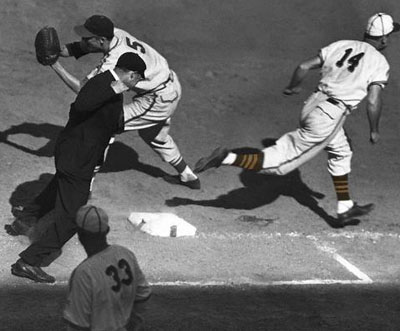
Sanders takes throw to complete double play on Al Zarilla. Game Five
- For the pivotal game, the managers reverted to their starters from Game One.
- Galehouse pitched well again, striking out ten and limiting the Cards to just six hits. But they made the most of them.
- Sanders smacked a homer in the 6th to break the scoreless tie, and Litwhiler clouted another in the 8th to add an insurance run. Denny always claimed that neither ball would have left the park without the aid of the wind.
- Cooper gave up seven hits, five more than in Game One, but shut out the Browns. He fanned twelve for a combined 22 to set a Series record for most by two teams in a game that stood for nineteen years.
- Sewell's club would now have to win both remaining games to complete their dream season.
Game Six
- Potter again faced Lanier with the Browns in a must-win situation for the first time.
- Both pitched well, but two unearned runs - for a total of seven for the Series - did in the American League champs.
- Laabs tripled in the 2nd and scored on McQuinn's single to give the Browns a 1-0 lead. Little did they know they would get only one more hit the rest of the way.
- The fateful inning was the bottom of the 4th. With one out, C Cooper drew a base on balls. Sanders singled to center, sending Walker to third. Kurowski hit a double play grounder to Stephens who fumbled the ball for a moment, enough to throw off the timing, so that Gutteridge was just past second when he took Vern's throw. The relay to first was late. So instead of the side being retired, Cooper scored, and Cardinals roosted on first and second. After Marion fouled out, Verban's single to left field drove home Ray and sent Whitey to third. Emil hit only .257 during the season, the lowest mark of any Cardinal starter. So the Browns staff didn't even discuss him before the Series. But his .412 average led all hitters. Lanier helped his own cause with a single through shortstop, scoring Kurowski. Bob Muncrief relieved and put out the fire. The Redbirds would score no more, but they wouldn't need to.
- In the sixth, Lanier walked two and uncorked a wild pitch to advance the runners. With the tying run on second Southworth brought in Wilks who got out of that jam and retired all eleven batters he faced to seal the 3-1 triumph and the Series victory for the Cardinals.
- In the final three games, the Browns scored just two runs.
1944 World Series highlights video
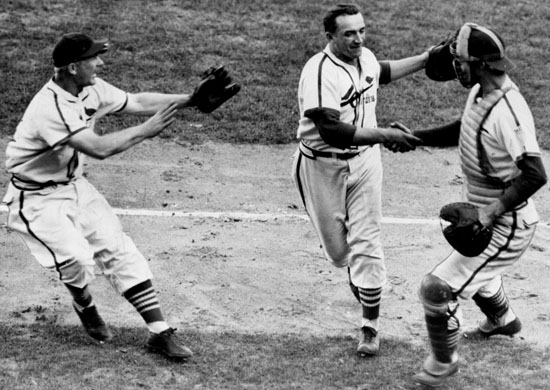
Kurowski and Cooper rush to congratulate Ted Wilks after final out of 1944 World Series.

Cardinals celebrate 1944 World Series win.
References: Even the Browns: The Zany, True Story of Baseball in the Early Forties,
William B. Mead (1978)
The Spirit of St. Louis: A History of the St. Louis Cardinals and Browns,
Peter Golenbock (2000) |
Did the Cardinals Threaten to Strike against Robinson?
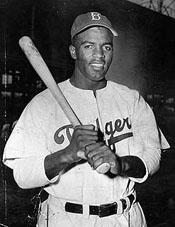
Jackie Robinson
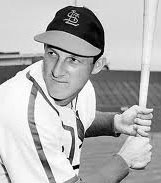
Stan Musial
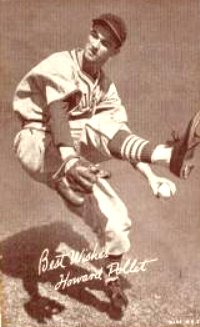
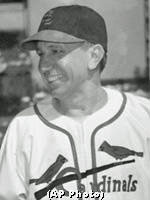
Eddie Dyer


Sam Breadon
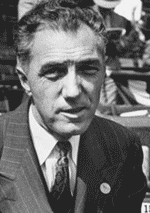
Ford Frick
|
The 1947 Cardinals made their first visit to Brooklyn for a three game series May 6-8.
- The significance, of course, was the fact that the Dodgers' roster included Jackie Robinson, the first African-American player in MLB in the 20th century.
- Brooklyn took the first game of the series 7-6 before an afternoon crowd of 18,971 at Ebbets Field. The defeat continued the defending World Series champions' miserable start, lowering their record to 3-12. Some writers charged that the Redbirds were unhappy because owner Sam Breadon had raised the salaries of only a few stars, including Stan Musial, and not by much.
- The next day, 18,971 turned out to watch the Cards even the series behind Howie Pollet 2-1.
- 32,328 gathered the following evening to watch Eddie Dyer's club win the series 5-1. The winning hurler was Harry Brecheen, the hero of the '46 Series when he won three times.
- No untoward incidents occurred involving Robinson.
The next day, May 9, the New York Herald-Tribune published a copyrighted article by sports editor Stanley Woodward that attracted national attention.
A National League players' strike, instigated by some of the St. Louis Cardinals against the presence in the league of Jackie Robinson, ... has been averted temporarily and perhaps permanently quashed. In recent days Ford Frick, president of the National League, and Sam Breadon, president of the St. Louis club, have been conferring with St. Louis players in the Hotel New Yorker. Mr. Breadon flew East when he heard of the projected strike. The story that he came to consult with Eddie Dyer, manager, about the lowly state of the St. Louis club was fictitious. He came on a much more serious errand.
The strike plan, formulated by certain St. Louis players, was instigated by a member of the Brooklyn Dodgers who has since recanted. The original plan was for a St. Louis club strike on the occasion of the first game in Brooklyn, May 6, in other words last Tuesday. Subsequently the St. Louis players conceived the idea of a general strike within the National League on a certain date. That is what Frick and Breadon have been combatting in the last few days.
Woodward claimed that Frick addressed the players as follows:
If you do this you will be suspended from the league. You will find that the friends you think you have in the press box will not support you, that you will be outcasts. I do not care if half the league strikes. Those who do it will encounter quick retribution. All will be suspended and I don't care if it wrecks the National League for five ydars. This is the United States of America and one citizen has as much right to play as another. The National League will go down the line with Robinson whatever the consequences. You will find if you go through with your intention that you have been guilty of complete madness.
Stanley added at the end of the article: It is understood that St. Louis players recently have been talking about staging the strike on the day that Brooklyn plays its first game in St. Louis. Publicity probably will render the move abortive.
On the same day the Herald article appeared, the Associated Press sent out a report from New York on a telelphone conversation with Frick.
- Ford said that Breadon came to New York the previous week to warn him of a movement among the Cardinals to strike rather than play against the Dodgers.
- Frick: I didn't have to talk to the players myself. Mr. Breadon did the talking to them. From what he told me afterward the trouble was smoothed over. I don't know what he said to them, who the ringleader, if any, was, or any other details.
- Breadon confirmed the conversation with Frick: I went to New York last week to see what could be done to help the ball club, and a St. Louis reporter with the club told me he understood there was some dissatisfaction among the National league players - not the Cardinals, mind you - about playing against Robinson.
I decided to talk the thing over with some of the men because it would be such a terrible thing, and I brought the matter up with two of my leading players. I was happy to find there was no dissatisfaction among the players. They never intimated that such a thing was even thought of.
- Dyer after the final game of the Brooklyn series: The report my club threatened a strike against Robinson is absurd. At no time to my knowledge did my players consider such a foolish action. They never discussed it. No one ever discussed it with them.
He also contradicted what his owner had said. At no time, to my knowledge, did he [Breadon] meet the players, or talk to them about any friction or anything else. As for Mr. Frick, he can investigate all he wants to. He will find that at no time did my players discuss anything resembling a strike of any sort. There is absolutely no friction on the club.
As for Robinson, I would like to state for myself and for all my players that if Brooklyn wants to use him and thinks he can be of value to the club, that certainly is all right with us. He is an American the same as I am and he is entitled to all the rights and privileges I am.
In later years, Frick and some of the Cardinals players shared their recollections of the strike incident.
- Frick wrote in his memoirs that the incident had occurred six weeks earlier (which would put it in spring training), and that Woodward should have known that. He considered the alleged plan nothing more than players blowing off steam. You know baseball players. They're like anybody else. They pop off. Sitting around the table with a drink or two they commit many acts of great courage but they don't follow through. My feeling was that it was over and done with. We had no more trouble.
- Musial told Roger Kahn many years later: I heard talk. It was rough and racial and I can tell you a few things about that. ... This is big league baseball, not English tea, and ballplayers make noise. So I heard the words and I knew there was some feelings behind the words, but I didn't take it seriously. That was baseball.
When asked if he spoke against the proposed strike, Stan replied: For me at the time - I was 26 - saying all that would have been a speech and I didn't know how to make speeches. Saying it to older player, that was beyond me. Besides, I thought the racial talk was just hot air.
- Bob Broeg, Hall of Fame sportswriter for the St. Louis Post-Dispatch starting in 1945: There was no threat to stike against Robinson. There was talk on all clubs, but the Cardinals had no plans to strike. I know, because I was with them. He added in his 1995 autobiography: Yes, Stanley Woodward could foul up, and he did with that inaccurate eight-columned banner headline. To this day, the New York press has never set the story straight. How irritating! How unfair!
- Peter Golenbock interviewed several members of the '47 Cardinals for his book The Spirit of St. Louis: A History of the St. Louis Cardinals and Browns. Stan Musial and Marty Marion explained what they saw and experienced during that tense period when Jackie Robinson broke baseball's color barrier. All deny categorically that the Cardinals ever threatened to go on strike against Robinson. ... As a journalist, you get to know your subjects. I spent many hours with Bob Broeg, Stan Musial, and Marty Marion. They all spoke honestly, about themselves and their teammates, covering a range of topics. I am convinced they were being truthful about this subject as well.
|
|
|